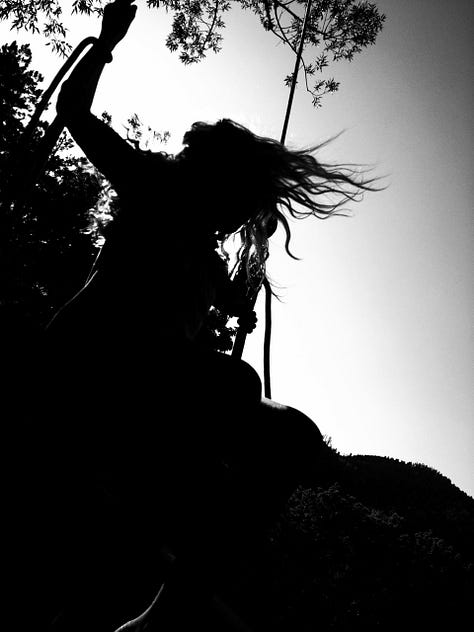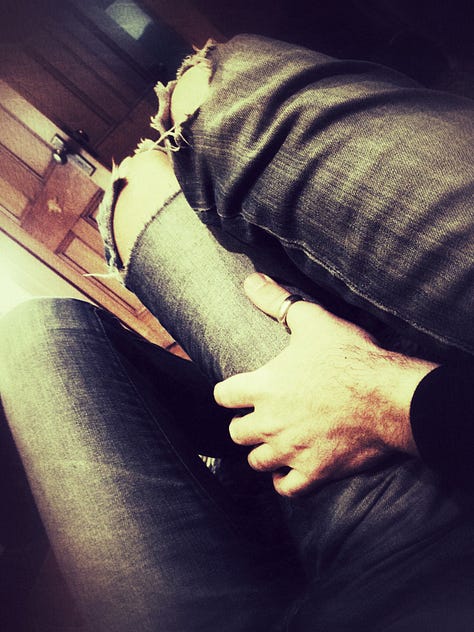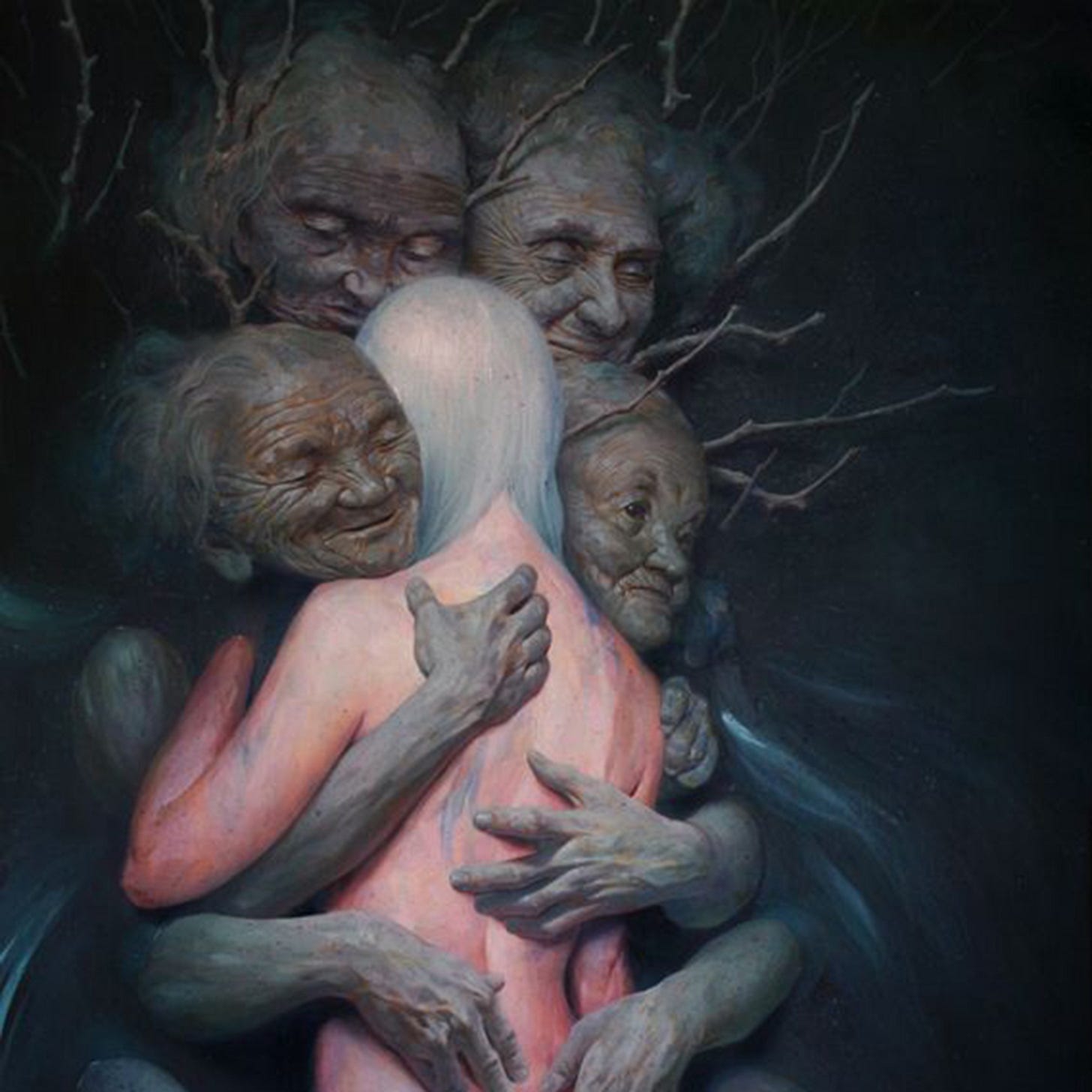Last week, enthusiastic spring winds blew a significant Big Leaf Maple limb to the ground, her leafy branches undone near our back door. I investigated the scene, wondering what cosmic joke busted her laugh lines into flight.
The earth beams crow’s feet everywhere I look, and not just as branches, or rippling echoes on water and sand. Flower carpels draw sparkle lines on the horizon. Morning forests sunbeam laugh lines. Sedimentary rock distinguishes her merriment with creases of color. Tree rings, spiderwebs, tributaries, root systems, even wind-whipped hair and whiskers mirror the sound waves of time, radiating the whimsy of what was, what is, and what’s to come.
Speaking of what’s to come, I turn fifty next year. Five decades of surfing the ripples of the great primordial laugh that ripped through a plasma of superheated particles when our Universe first formed. These overlapping ripples filled the darkness like the surface of a pond pounded by stones and later spawned galaxies.
When I smile, fragments of these ripples extend from the corners of my eyes. When I laugh, I wrinkle time as mom’s joy, her mom’s joy, and her mom’s mom’s joy reverberate back to the beginning when the Universe surely cracked up at her own stunning existence. I never knew dad’s mom but I’m sure her sonic waves of joy are on my face too. Jeremy Enecio's illustration “Maelstrom” depicts our ancestral smile lines with loving detail. I rest myself in the center of the image—cosmos harmonizing through skin—and ponder Einstein’s crucial question:
Yes sir, it feels like the Universe is friendly.
Have you ever noticed that a simple line drawing of a crow’s foot looks a lot like the peace sign? Originally designed as a logo for the British Campaign for Nuclear Disarmament, this symbol superimposed the semaphore signals for the letters “N” and “D.” But when our faces age and peace signs stretch across orbital bones, do we see this positive symbol of life and cooperation sparkling from our eyes or the more maligned representation of an upside-down cross, a fallen man, a harbinger of death or a witch’s foot? Do we Botox and banish them into non-existence or gleam in peaceful protest? Why call them crow’s feet? Why not sloth’s feet or kitten whiskers or blossoming forsythia? Would we dare erase a display of god-rays from the corners of our eyes?
It turns out the choice of bird and her digits was intentional. The term “crow’s feet”—originating between 1100-1500 was meant to be unflattering. Crows have long been regarded with negativity. But while some disparage crows and view them as pests, scavengers and bad omens, I join other traditions where crows symbolize wisdom, transformation, prophecy and profound equanimity. Crow medicine, or as the Cherokee call it, Koga Nvwati, believes the crow is a shape-shifter and keeper of all sacred law, protecting and promoting the ancient knowledge that physical and spiritual worlds are not separate. She caws, rattles, purrs, croaks, and even whispers her wisdom; and depending on the timbre, or the number and speed of repetitions, her meaning is almost as varied and complex as human language, conveying everything from danger to companionship. Four years ago when a neighbor clear-cut a nearby grove of Doug Firs, a murder of crows made their grief known—a 4:00am dirge beseeched the pre-dawn sky to return spirit to matter and mend human’s senseless unstitching. With eyes closed, I heard their black bodies swirling overhead, feet unmoored from quiet roosting—the metallic groan of tree fellers no match for their three-toed cry for peace.
I gladly join their plea every time I smile.
What embodiment more accurately reflects a lifetime of merriment than crow’s feet? One extensive study at the University of Louvain, Belgium revealed that people with crow’s feet are not only viewed as happier, but more intelligent, friendlier, competent, and trustworthy. Crow’s feet around our eyes are so important in psychology there’s a name for them. Duchenne markers—an eponym of the French anatomist Duchenne de Boulogne who identified the contracting muscles atop our orbital bones—distinguish a real smile from fake and are the only type of smile that evokes in the recipient heightened activity in the anterior cortex, or “happy center” of the brain. Go ahead, flash a toothy grin and flood your neighbor’s noodle with a bit of sunshine. When he sees your smile, it’ll be difficult to frown—our mirror neurons evolved to mimic smiles in order to better understand the emotional state of our friend or foe.
We didn’t need a study to know that smiles are contagious. But facial expressions are not only external manifestations of internal states, but can themselves trigger or modulate our own emotional experiences. Studies have shown that an authentic smile—all teeth, cheek and crinkle—spurs a powerful chemical reaction in the brain that makes you happier and more relaxed by releasing endorphins, serotonin, and other natural painkillers. Author of Smile: The Astonishing Powers of a Simple Act Ron Gutman wrote, “British researchers found that one smile can generate the same level of brain stimulation as 2,000 bars of chocolate.” I have a hard time believing this but I’ll still practice caution next time I eat a bar of chocolate while laughing. <exploding head emoji > The marathon world record holder Eliud Kipchoge smiles as wide as a mile while he runs and a recent study published in Psychology of Sport and Exercise says his grin might be helping him go the distance—runners who smile use less oxygen, run more economically and have a lower perceived rate of exertion than those who frowned. Even a “fake it ‘til you make it” grin will work if that’s all you can muster. Synthetically inhibited facial expressions have powerful effects as well—when researchers restricted frown muscles using Botox, subjects with major depressive disorder reported feeling happier;1 and conversely, a smaller, more recent study out of Wales found that people treated for crow’s feet felt more depressed.2 If that doesn’t win your vote to exalt smile lines, I don’t know what will.
But our beaming brigade has a battle ahead. When I google “crow’s feet” it’s as if I’d accidentally typed “demonic possession”, my browser window flooding with “How do I get rid of my crow’s feet?” “Help! I’m getting crow’s feet!” and “Banish crow’s feet now!” Exorcisms delivered with the prick of a needle. Will the Alpha kids—similar to Gen Z’s disdain for their parents’ tattoos—renounce the era of #frozenface?
“Daddy, how did you get so many wrinkles around your eyes?” a friend’s four-year-old daughter recently asked.
“You have to earn them through a lifetime of smiling.”
Stretching her aspiring smile lines to their limit, she beamed, “No fair. I want wrinkly eyes too.” There is hope.
May we all wear our scars of accumulated joy with the same pride, our mouths insufficient to contain the overflow. Do crow’s feet fulfill the Universe’s dream to know itself through expansion? Ripple upon overlapping ripple of cackling stars? I don’t know. But I want to believe that your laughing eyes are the sons and daughters of a friendly void. But if I’m wrong, and the Universe is hostile or indifferent, let’s beam contagious crows feet into the infinite and see if eventually, she smiles back.
When a crow alights on orbital bones poised proud with ancient song listen for the echo the reverb, the great primordial gong; it reaches back in time when spirit and matter burst into two infinite ripples of mirth creating you, you and you; crow loves her perch standing true in your delight 'til the day her wings unfurl and we merge in boundless flight.









PREVIOUS POST: In Defense of Beige
Frown lines are also referred to as “11’s”—the two lines between one’s eyes that deepen with every Pacific Northwest stink bug invasion. Treatment of depression with Botulinum toxin A: case series, Dr. Eric Finzi and Dr. Erika Wasserman, May 2006, https://www.medicalnewstoday.com/articles/43776#1
In my research, it was much easier to find information on the positive mental health effects of using Botox on frown lines. Are neuromodulation companies doing their best to keep these smaller studies connecting frozen smile lines and depression less ubiquitous? The interactions between botulinum-toxin-based facial treatments and embodied emotions, October 2018, Dr. Michael Lewis of the School of Psychology, Cardiff, Wales https://www.medicalnewstoday.com/articles/259072






My grandma, who I thought was beautiful, radiated crow’s feet each time she smiled. So naturally, as a kid, I’d scrunch my eyes so that I could look more like her. Eventually, happily, I succeeded.
It never occurred to me to not admire them.